Are you craving the tangy, refreshing taste of ceviche and wondering where in Mexico this delightful dish originates? At gaymexico.net, we’re diving deep into the heart of Mexican cuisine to uncover the regional roots of ceviche, especially for our LGBTQ+ travelers and community members who love to explore and savor authentic experiences. Ceviche is more than just food; it’s a cultural experience. Join us as we explore its origins and some of the best places to enjoy it, while ensuring a safe and welcoming experience for everyone. Discover the vibrant flavors of Mexico with us and plan your next culinary adventure!
1. Unveiling the Origins of Ceviche: A Coastal Culinary Treasure
Ceviche’s history in Mexico is a fascinating journey through the country’s diverse coastal regions. While ceviche-like dishes have ancient roots across Latin America, Mexico has embraced and evolved this seafood delicacy, making it a staple of its coastal cuisine. Ceviche is a source of pride for Mexicans, reflecting the country’s culinary ingenuity and its love for fresh, vibrant flavors.
1.1. Coastal States: The Birthplace of Mexican Ceviche
The true origin of ceviche in Mexico is somewhat debated, with several coastal states laying claim to its creation. Some of the most prominent regions include:
- Guerrero: Known for its ceviche guerrerense, often prepared with finely chopped white fish, tomatoes, onions, cilantro, and a touch of serrano pepper, marinated in lime juice.
- Veracruz: This Gulf Coast state boasts its version of ceviche, typically featuring fish, shrimp, or a mix of seafood, marinated with lime, tomatoes, onions, and green olives, giving it a unique Mediterranean twist.
- Acapulco: This famous beach resort town in Guerrero is a hotspot for ceviche, with countless restaurants and street vendors offering their unique takes on the dish.
- Oaxaca: Known for its culinary diversity, Oaxaca’s coastal regions offer ceviche variations that include local ingredients like chapulines (grasshoppers) or unique chili peppers.
1.2. The Role of Fresh Ingredients: The Key to Authentic Ceviche
The quality of ceviche relies heavily on the freshness of its ingredients. The closer you are to the coast, the fresher the seafood, and the more vibrant the flavors. Lime juice plays a crucial role, as it not only “cooks” the seafood through denaturation but also adds a zesty flavor that defines ceviche. Fresh vegetables like tomatoes, onions, and cilantro contribute to the dish’s overall texture and aroma.
1.3. Ceviche’s Evolution: From Ancient Tradition to Modern Delight
Over time, ceviche has evolved in Mexico, incorporating various regional ingredients and culinary techniques. From the simple preparations of the past to the more elaborate versions of today, ceviche remains a beloved dish enjoyed by locals and tourists alike.
2. Decoding Ceviche: Ingredients, Preparation, and Regional Variations
Ceviche, at its core, is a simple dish: seafood marinated in citrus juice. However, the beauty of ceviche lies in its versatility and the countless variations that exist across Mexico. Let’s break down the essential elements of ceviche and explore some of the most popular regional twists.
2.1. Core Components: The Building Blocks of Ceviche
- Seafood: The most common choices include white fish (such as sea bass, snapper, or mahi-mahi), shrimp, octopus, scallops, and tuna. The seafood must be incredibly fresh to ensure both flavor and safety.
- Citrus Juice: Lime juice is the quintessential ingredient, providing the acidity needed to “cook” the seafood and impart a tangy flavor. Some recipes also incorporate lemon or orange juice for added complexity.
- Aromatic Vegetables: Onions, tomatoes, and cilantro are essential for adding freshness, texture, and aromatic depth.
- Chili Peppers: Jalapeños, serranos, or habaneros are used to introduce heat, with the type and amount varying depending on regional preferences.
- Seasoning: Salt and pepper are the basic seasonings, but many cooks also add oregano, cumin, or other spices to enhance the flavor.
- Optional Additions: Avocado, cucumber, olives, and even fruit like mango or pineapple can be added for extra flavor and texture.
2.2. The Marination Process: “Cooking” Without Heat
The magic of ceviche happens during the marination process. The citric acid in the lime juice denatures the proteins in the seafood, causing it to firm up and become opaque, similar to cooking with heat. The marination time varies depending on the type of seafood and the desired texture, but it typically ranges from 15 minutes to a few hours.
2.3. Regional Ceviche Styles: A Taste of Mexico’s Diversity
- Ceviche de Pescado (Fish Ceviche): This classic version is made with white fish, lime juice, onions, tomatoes, cilantro, and chili peppers. It’s a staple in many coastal regions and a great starting point for exploring ceviche.
- Ceviche de Camarón (Shrimp Ceviche): Shrimp ceviche is incredibly popular, especially in areas where shrimp is abundant. It’s often made with cooked or raw shrimp, marinated in lime juice with the usual aromatics and spices.
- Ceviche de Pulpo (Octopus Ceviche): Octopus ceviche is a delicacy, featuring tender, cooked octopus marinated in lime juice with onions, tomatoes, and cilantro. It’s known for its unique texture and flavor.
- Ceviche Mixto (Mixed Ceviche): This version combines various types of seafood, such as fish, shrimp, octopus, and scallops, creating a symphony of flavors and textures.
- Ceviche Guerrerense: This style from Guerrero is known for its simplicity and freshness, using finely chopped fish, tomatoes, onions, cilantro, and serrano peppers.
- Ceviche Veracruzano: From Veracruz, this ceviche features fish or shrimp marinated with lime, tomatoes, onions, and green olives, giving it a distinctive Mediterranean flair.
3. Savoring Ceviche: Top Destinations in Mexico for the Best Bites
Mexico’s coastal regions offer endless opportunities to indulge in delicious ceviche. Whether you’re seeking a casual beachside snack or a gourmet dining experience, you’ll find plenty of options to satisfy your ceviche cravings. Here are some of the top destinations for ceviche in Mexico:
3.1. Ensenada, Baja California: A Seafood Lover’s Paradise
Ensenada, located in Baja California, is renowned for its fresh seafood and vibrant culinary scene. The city’s Mercado Negro (Black Market) is a must-visit for seafood lovers, offering a wide array of ceviche options, from classic fish ceviche to more adventurous combinations.
3.2. Mazatlán, Sinaloa: The Pearl of the Pacific
Mazatlán, known as the “Pearl of the Pacific,” boasts a rich seafood tradition and some of the best ceviche in Mexico. The city’s malecón (boardwalk) is lined with restaurants and street vendors serving up delicious ceviche, often accompanied by stunning ocean views.
3.3. Puerto Vallarta, Jalisco: A Blend of Tradition and Innovation
Puerto Vallarta, a popular tourist destination on the Pacific coast, offers a diverse culinary scene that includes both traditional and innovative ceviche creations. Many restaurants in the Zona Romántica (Romantic Zone) cater to LGBTQ+ travelers and offer a welcoming atmosphere to enjoy local cuisine.
3.4. Playa del Carmen, Quintana Roo: Caribbean Flavors
Playa del Carmen, located on the Riviera Maya, is known for its beautiful beaches and vibrant nightlife. The city’s ceviche scene reflects its Caribbean influences, with many restaurants offering ceviche made with local seafood and tropical fruits.
3.5. Oaxaca Coast: Hidden Gems and Culinary Delights
Oaxaca’s Pacific coast is home to several hidden gems that offer unique ceviche experiences. Towns like Puerto Escondido and Zipolite are known for their laid-back atmosphere and delicious seafood, with ceviche being a staple of the local diet.
4. LGBTQ+ Travel in Mexico: A Guide to Welcoming Destinations
Mexico is becoming increasingly welcoming to LGBTQ+ travelers, with many destinations offering inclusive and safe environments. While attitudes may vary depending on the region, many cities and towns have embraced diversity and offer a vibrant LGBTQ+ scene.
4.1. Mexico City: A Cosmopolitan Hub
Mexico City is a cosmopolitan hub with a thriving LGBTQ+ community. The Zona Rosa (Pink Zone) is the city’s gay neighborhood, offering a wide range of bars, clubs, restaurants, and shops catering to LGBTQ+ travelers.
4.2. Puerto Vallarta: A Gay Paradise
Puerto Vallarta is widely considered one of the most gay-friendly destinations in Mexico. The city’s Zona Romántica is home to a vibrant LGBTQ+ scene, with numerous gay bars, clubs, and hotels. Puerto Vallarta also hosts an annual Pride celebration that attracts thousands of visitors from around the world.
4.3. Guadalajara: A Cultural Gem
Guadalajara, Mexico’s second-largest city, offers a rich cultural heritage and a growing LGBTQ+ scene. The city’s Chapultepec neighborhood is home to several gay bars and clubs, and Guadalajara also hosts an annual Pride celebration.
4.4. San Miguel de Allende: A Colonial Charm
San Miguel de Allende, a UNESCO World Heritage Site, is known for its colonial architecture and artistic atmosphere. The city has a growing LGBTQ+ population and offers a welcoming environment for gay travelers.
4.5. Cancun and Riviera Maya: Beachside Bliss
Cancun and the Riviera Maya are popular tourist destinations that offer a range of LGBTQ+-friendly resorts and activities. While the LGBTQ+ scene may not be as concentrated as in other cities, many hotels and tour operators cater to gay travelers.
5. Tips for LGBTQ+ Travelers in Mexico: Ensuring a Safe and Enjoyable Trip
While Mexico is becoming more accepting of LGBTQ+ travelers, it’s essential to be aware of local customs and attitudes. Here are some tips to help ensure a safe and enjoyable trip:
5.1. Research Your Destination:
Before you go, research the LGBTQ+ friendliness of your destination. Some cities and towns are more welcoming than others.
5.2. Be Aware of Public Displays of Affection:
While public displays of affection are becoming more accepted in some areas, it’s still best to be discreet in more conservative regions.
5.3. Learn Some Basic Spanish:
Knowing some basic Spanish phrases can help you navigate local customs and communicate with locals.
5.4. Use LGBTQ+-Friendly Resources:
Utilize online resources and travel guides that cater to LGBTQ+ travelers to find safe and welcoming establishments.
5.5. Trust Your Instincts:
If you feel uncomfortable in a situation, remove yourself from it. Trust your instincts and prioritize your safety.
5.6. Stay Informed:
Keep up-to-date on current events and any travel advisories that may affect LGBTQ+ travelers.
6. Exploring Mexico’s Culinary Landscape: Beyond Ceviche
While ceviche is a must-try dish, Mexico’s culinary landscape offers so much more to explore. From tacos and enchiladas to mole and tamales, Mexican cuisine is a symphony of flavors, textures, and aromas.
6.1. Tacos: A Mexican Staple
Tacos are arguably Mexico’s most iconic dish, and for good reason. These versatile treats consist of tortillas filled with various meats, vegetables, and toppings. From tacos al pastor (marinated pork) to tacos de pescado (fish tacos), there’s a taco for every palate.
6.2. Enchiladas: A Cheesy Delight
Enchiladas are tortillas filled with meat, cheese, or vegetables, rolled up, and covered in sauce. They are typically baked or fried and often topped with cheese, sour cream, and onions.
6.3. Mole: A Complex Sauce
Mole is a complex sauce made from chili peppers, spices, chocolate, and other ingredients. It’s a staple of Oaxacan cuisine and comes in various forms, from mole negro (black mole) to mole poblano (red mole).
6.4. Tamales: A Steamed Treat
Tamales are made from masa (corn dough) filled with meat, cheese, or vegetables, wrapped in corn husks or banana leaves, and steamed. They are a popular dish during holidays and celebrations.
6.5. Street Food: A Culinary Adventure
Exploring Mexico’s street food scene is a culinary adventure in itself. From elotes (grilled corn on the cob) to esquites (corn salad) and marquesitas (crispy crepes), you’ll find a wide array of delicious and affordable snacks on the streets of Mexico.
7. Where in Mexico to Enjoy the Best Ceviche: Top Picks
Finding the best ceviche in Mexico depends on your personal preferences, but here are a few highly-regarded spots to start your culinary journey:
| Restaurant Name | Location | Specialty | Price Range | LGBTQ+ Friendly |
|---|---|---|---|---|
| La Guerrerense | Ensenada, Baja California | Seafood cart with award-winning ceviche | $ | Yes |
| Mariscos Mocambo | Veracruz, Veracruz | Traditional Veracruz-style ceviche | $$ | Yes |
| Contramar | Mexico City | Tuna ceviche with avocado and chipotle mayo | $$$ | Yes |
| El Fish Market | Puerto Vallarta, Jalisco | Fresh ceviche with ocean views | $$ | Yes |
| Holbox | Los Angeles, CA (Inspired by Yucatán Ceviche) | Unique ceviche creations with local ingredients | $$$ | Yes |
8. The Health Benefits of Ceviche: A Nutritious Delight
Beyond its delicious taste, ceviche offers several health benefits:
8.1. High in Protein:
Seafood is an excellent source of protein, which is essential for building and repairing tissues.
8.2. Rich in Omega-3 Fatty Acids:
Omega-3 fatty acids are beneficial for heart health and brain function.
8.3. Low in Calories:
Ceviche is relatively low in calories, making it a healthy option for those watching their weight.
8.4. Good Source of Vitamins and Minerals:
Seafood is rich in vitamins and minerals, such as vitamin D, vitamin B12, iron, and zinc.
8.5. Fresh and Natural:
Ceviche is made with fresh, natural ingredients, without any added preservatives or artificial flavors.
9. Making Ceviche at Home: A Step-by-Step Guide
Want to try your hand at making ceviche at home? Here’s a simple recipe to get you started:
Ingredients:
- 1 pound fresh white fish (such as sea bass or snapper), cut into small cubes
- 1 cup fresh lime juice
- 1/2 cup red onion, finely chopped
- 1/2 cup tomato, finely chopped
- 1/4 cup cilantro, finely chopped
- 1-2 jalapeño peppers, seeded and minced (optional)
- Salt and pepper to taste
- Avocado slices for serving (optional)
- Tostadas or tortilla chips for serving
Instructions:
- In a glass bowl, combine the fish and lime juice. Make sure the fish is completely submerged in the juice.
- Cover the bowl and refrigerate for 15-20 minutes, or until the fish is opaque and firm.
- Drain the lime juice from the fish.
- Add the red onion, tomato, cilantro, and jalapeño (if using) to the fish.
- Season with salt and pepper to taste.
- Mix well and refrigerate for another 10 minutes to allow the flavors to meld.
- Serve immediately with avocado slices and tostadas or tortilla chips.
10. Frequently Asked Questions About Ceviche
10.1. Is ceviche raw fish?
While the fish in ceviche is not cooked with heat, the citric acid in the lime juice denatures the proteins, effectively “cooking” the fish. However, it’s essential to use fresh, high-quality seafood to minimize the risk of foodborne illness.
10.2. How long does ceviche last?
Ceviche is best enjoyed fresh, but it can be stored in the refrigerator for up to 2 days. However, the texture of the seafood may change over time.
10.3. Can I use frozen fish for ceviche?
Yes, you can use frozen fish for ceviche, but make sure to thaw it completely before marinating.
10.4. What is the best type of fish for ceviche?
The best type of fish for ceviche is fresh, white fish with a firm texture, such as sea bass, snapper, or mahi-mahi.
10.5. Can I make ceviche with cooked shrimp?
Yes, you can make ceviche with cooked shrimp. Simply marinate the shrimp in lime juice with the other ingredients.
10.6. Is ceviche spicy?
Ceviche can be spicy, depending on the amount and type of chili peppers used. If you prefer a milder flavor, use less chili pepper or remove the seeds before adding them to the ceviche.
10.7. What is the origin of the word “ceviche”?
The origin of the word “ceviche” is uncertain, but it may come from the Quechua word “siwichi,” which means fresh fish.
10.8. What are some popular ceviche toppings?
Popular ceviche toppings include avocado slices, hot sauce, and cocktail sauce.
10.9. Can I make vegan ceviche?
Yes, you can make vegan ceviche using ingredients like hearts of palm, mushrooms, or cauliflower marinated in lime juice with vegetables and spices.
10.10. What is the difference between ceviche and aguachile?
Aguachile is a type of ceviche from Sinaloa, Mexico, that is typically spicier and served immediately after marinating in lime juice. Ceviche, on the other hand, can be marinated for a longer period and may include a wider range of ingredients.
Conclusion: Embrace the Flavors of Mexico with gaymexico.net
From its coastal origins to its diverse regional variations, ceviche is a culinary treasure that reflects Mexico’s rich culture and vibrant flavors. Whether you’re an LGBTQ+ traveler seeking a safe and welcoming destination or a food lover eager to explore new tastes, Mexico offers a feast for the senses.
At gaymexico.net, we’re committed to providing you with the most up-to-date information and resources to help you plan your perfect trip. From LGBTQ+-friendly travel guides to insider tips on the best ceviche spots, we’ve got you covered.
So, what are you waiting for? Start planning your Mexican adventure today and discover the delicious flavors and welcoming culture that await you. Visit gaymexico.net for more information and inspiration.
Address: 3255 Wilshire Blvd, Los Angeles, CA 90010, United States. Phone: +1 (213) 380-2177.
Website: gaymexico.net.
Let gaymexico.net be your guide to an unforgettable experience in Mexico!
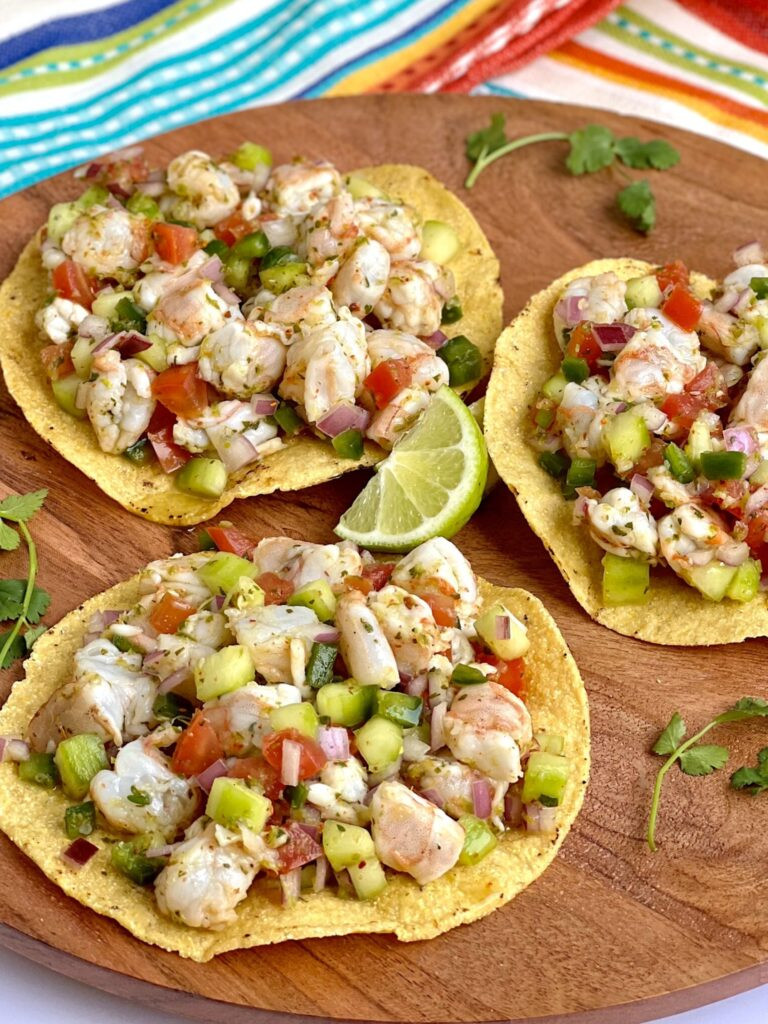 Mexican Shrimp Ceviche featuring ripe avocados
Mexican Shrimp Ceviche featuring ripe avocados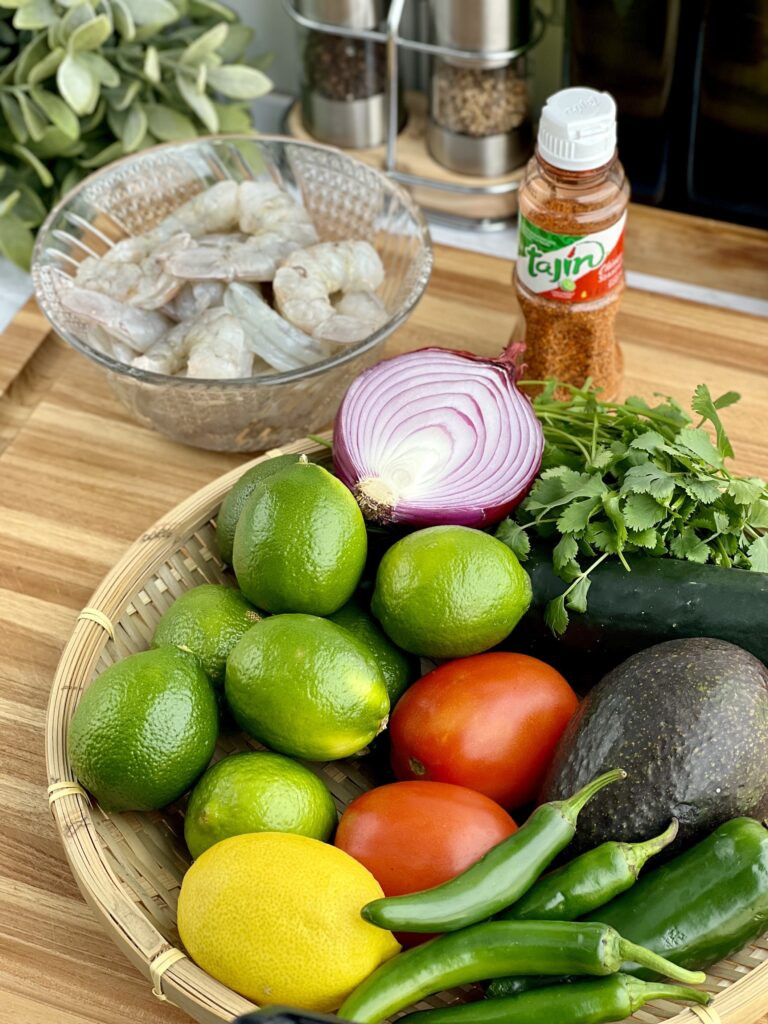 Ingredients for making Mexican ceviche
Ingredients for making Mexican ceviche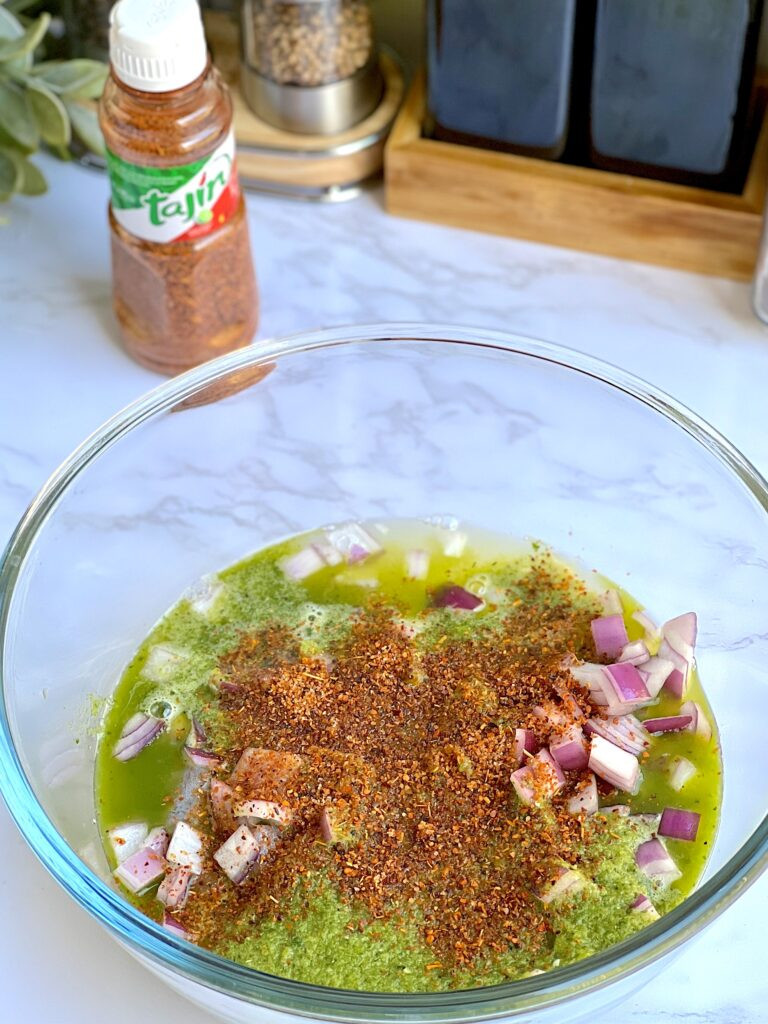 Tajin seasoning used in ceviche recipe
Tajin seasoning used in ceviche recipe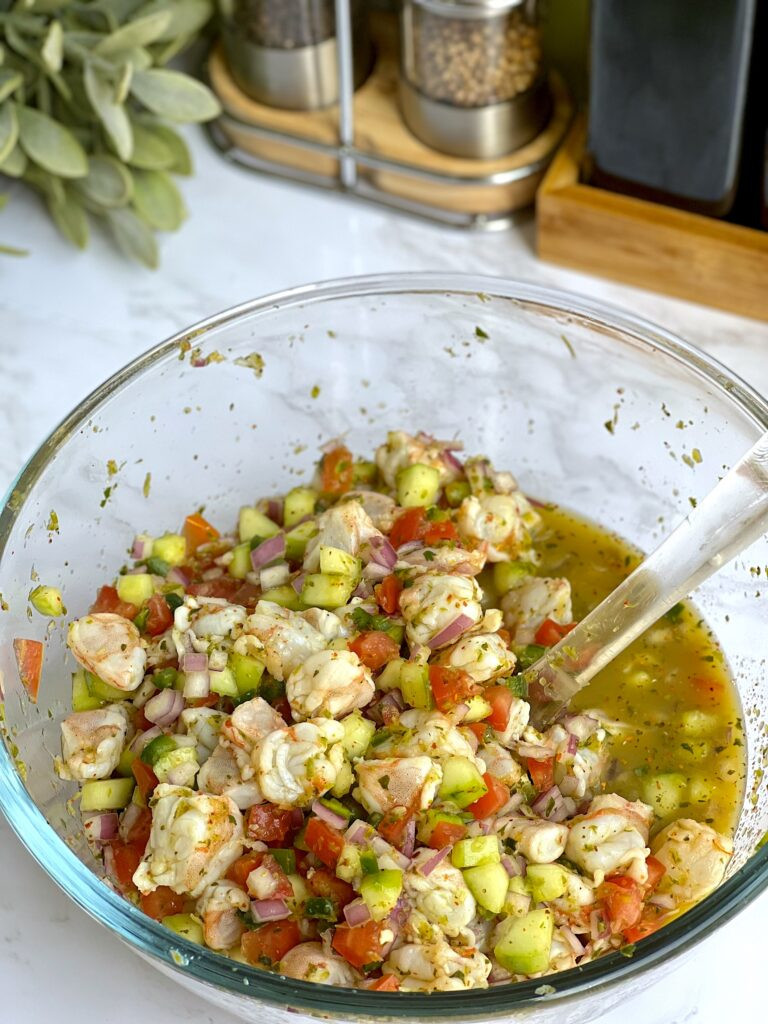 Close-up of shrimp being "cooked" in lime juice for ceviche
Close-up of shrimp being "cooked" in lime juice for ceviche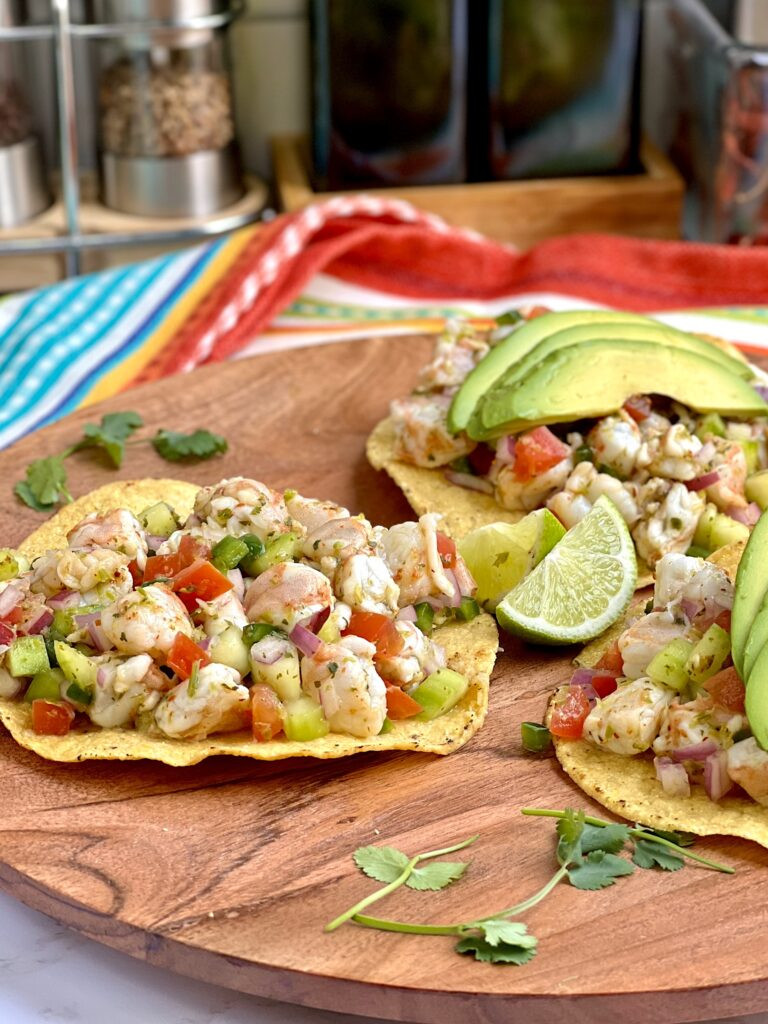 Serving suggestion for Mexican ceviche with Ritz crackers
Serving suggestion for Mexican ceviche with Ritz crackers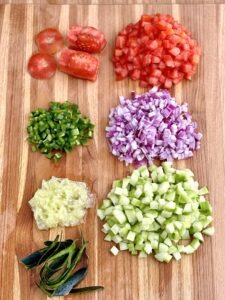 Preparation of the fresh vegetables, part of ceviche ingredients
Preparation of the fresh vegetables, part of ceviche ingredients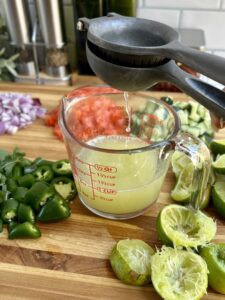 Squeezing fresh limes for ceviche marinade
Squeezing fresh limes for ceviche marinade Chopping fresh cilantro and serrano peppers to be blended into a mix
Chopping fresh cilantro and serrano peppers to be blended into a mix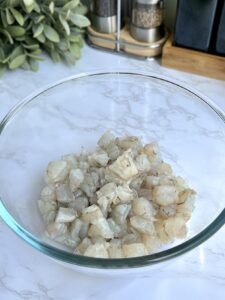 Cutting fresh shrimp into smaller pieces for making ceviche
Cutting fresh shrimp into smaller pieces for making ceviche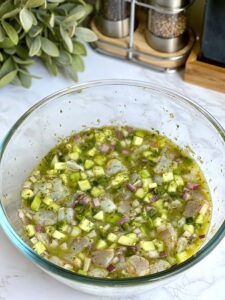 Marinating the shrimp in blended cilantro, serrano, and lime juice
Marinating the shrimp in blended cilantro, serrano, and lime juice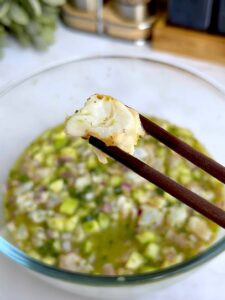 Shrimp ceviche marinated until pink and opaque
Shrimp ceviche marinated until pink and opaque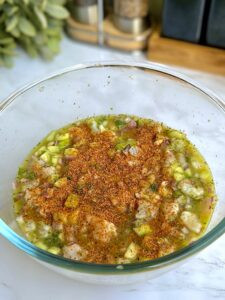 Adding Tajin seasoning to the freshly made ceviche
Adding Tajin seasoning to the freshly made ceviche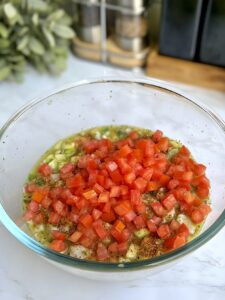 Adding tomato and avocado to the shrimp ceviche
Adding tomato and avocado to the shrimp ceviche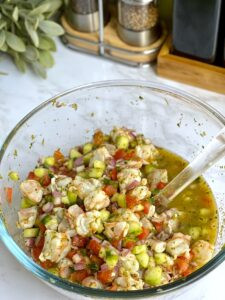 Thorough mixing of the shrimp ceviche ingredients
Thorough mixing of the shrimp ceviche ingredients